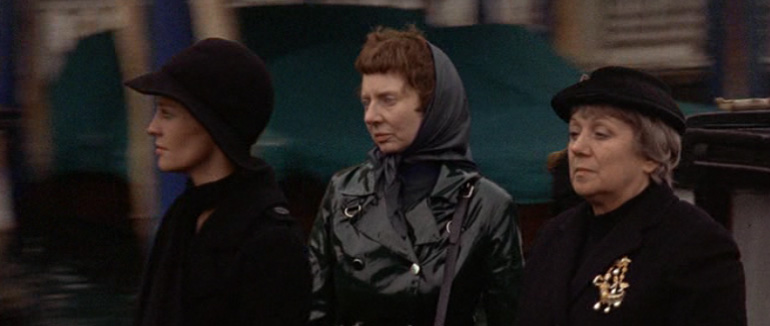Home Movies:
Appliqué
It was the “How Venice Works” vimeo that made me want to see Don’t Look Now last night. The jolly little short about the Venetian infrastructure left me feeling very sorry for myself, because it brought home what I wouldn’t be doing this fall: finally getting to Venice. (Regular readers know that we’ll be going to another, closer island instead, a month or so earlier.) Feeling sorry for myself about not seeing Venice — with a heap of napkins to be ironed: if ever there’s a state of mind more suited to watching Nicholas Roeg’s handheld horror film, I hope I never experience it.
I saw the movie when it came out, in 1973. What made it memorable wasn’t the grisly murder at the end, shocking as that was, but the love scene. And the way the love scene was shown in bits that alternated with the scene that followed, when the loving couple got dressed and ready to go out to dinner. There was the sex, which was very explicit for the time — pornographic, frankly; but redeemed by being claimed for marriage — and there was the playing with temporal frames, a fundamental and otherwise ominous element of the film.
Don’t Look Now is the opposite of a Hitchcock thriller: it blows its big secret the first time. There’s no going back to hoping, along with John Baxter (Donald Sutherland), that the petite figure in the red mac is the ghost of his dead little girl, Christine, who drowns in the movie’s opening scene. The last ten minutes of Don’t Look Now are pure, unrelieved melodrama, all bootless shrieks and running footsteps on the fondamento. And blood. And then, for the last scene, a stylish cortège (which John has foreseen — you see what I mean by temporal play), with Julie Christie looking chic and vaguely mad in a crushed cloche, shot from below. She’s wretched, but also exalted, transcendent — she knew she was right. What’s most salient now, though, is Pino Donaggio’s music, which is even more dated than Donald Sutherland’s outfits (which I still covet). How to describe it? Suave and romantic in the manner of the old studio movies, but with a sour, jazzy edge, a hipster wink that screams SIXTIES. Donaggio’s knowing score, with its faux-baroque runs during an agitated search scene, is in perfect accord with the famous love scene. Both promote the idea that Don’t Look Now is a classy film.
That is, you can have porn and you can have murder but if you play with them in an interesting way then what you’ve really got is, if not art, then something that won’t embarrass sophisticated audiencesc with vulgar appeals to the senses. You’ve got Donald Sutherland and you’ve got Julie Christie and you’ve got Venice and the restoration of an old church complete with an aristocratic bishop whose family has been patronizing the same tessera firm for generations. You’ve got the low-budget European look that handheld cameras still conveyed in 1973. Class, as I say. But the class is appliquéd. I’m reminded of Joseph Kerman’s famous dismissal of Tosca: Don’t Look Now is a shabby little shocker.
My point is not, however, to heap contumely upon Roeg’s movie, which I watched right through to the end even though I finished the ironing midway. My point is to recall that you could still do that in the early Seventies — paste a few arty elements on something and call it classy. Class, that’s to say, wasn’t a matter of style, a matter of filmmaking aesthetic. It was a bundle of references that cued the audience.
They really did make terrible movies in those days. Or, rather, they produced pretty good movies, but they made them badly.

